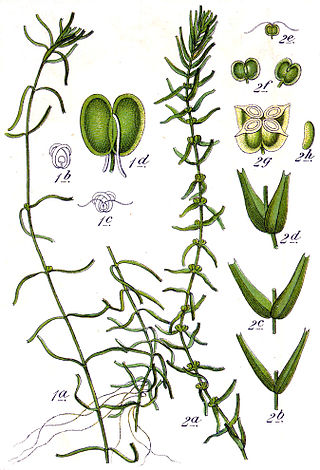
The Fagales are an order of flowering plants, including some of the best-known trees. The order name is derived from genus Fagus, beeches. They belong among the rosid group of dicotyledons. The families and genera currently included are as follows:

Fabales is an order of flowering plants included in the rosid group of the eudicots in the Angiosperm Phylogeny Group II classification system. In the APG II circumscription, this order includes the families Fabaceae or legumes, Quillajaceae, Polygalaceae or milkworts, and Surianaceae. Under the Cronquist system and some other plant classification systems, the order Fabales contains only the family Fabaceae. In the classification system of Dahlgren the Fabales were in the superorder Fabiflorae with three families corresponding to the subfamilies of Fabaceae in APG II. The other families treated in the Fabales by the APG II classification were placed in separate orders by Cronquist, the Polygalaceae within its own order, the Polygalales, and the Quillajaceae and Surianaceae within the Rosales.

The Magnoliales are an order of flowering plants.

The Poales are a large order of flowering plants in the monocotyledons, and includes families of plants such as the grasses, bromeliads, rushes and sedges. Sixteen plant families are currently recognized by botanists to be part of Poales.

Sapindales is an order of flowering plants. Well-known members of Sapindales include citrus; maples, horse-chestnuts, lychees and rambutans; mangos and cashews; frankincense and myrrh; mahogany and neem.

The Nymphaeales are an order of flowering plants, consisting of three families of aquatic plants, the Hydatellaceae, the Cabombaceae, and the Nymphaeaceae. It is one of the three orders of basal angiosperms, an early-diverging grade of flowering plants. At least 10 morphological characters unite the Nymphaeales. One of the traits is the absence of a vascular cambium, which is required to produce both xylem (wood) and phloem, which therefore are missing. Molecular synapomorphies are also known.

The Dilleniales are an order of flowering plants, potentially containing one family, Dilleniaceae. The APG III system of 2009, like the earlier APG II system of 2003, left the Dilleniaceae unplaced as to order, while noting that the name Dilleniales was available. Stevens at the Angiosperm Phylogeny Website has subsequently placed Dilleniaceae in the order Dilleniales.

Callitrichales is a proposed order of flowering plants. As circumscribed by American botanist Arthur Cronquist in the Cronquist system (1981), the order included three families:

Nepenthales is an order of carnivorous flowering plants in the Cronquist system of plant classification.
The Cronquist system is a taxonomic classification system of flowering plants. It was developed by Arthur Cronquist in a series of monographs and texts, including The Evolution and Classification of Flowering Plants and An Integrated System of Classification of Flowering Plants (1981).

Piperales is an order of flowering plants. It necessarily includes the family Piperaceae but other taxa have been included or disincluded variously over time. Well-known plants which may be included in this order include black pepper, kava, the many Peperomias, pepper elder, lizard's tail, birthwort, and wild ginger.

Ranunculales is an order of flowering plants. Of necessity it contains the family Ranunculaceae, the buttercup family, because the name of the order is based on the name of a genus in that family. Ranunculales belongs to a paraphyletic group known as the basal eudicots. It is the most basal clade in this group; in other words, it is sister to the remaining eudicots. Widely known members include poppies, barberries, hellebores, and buttercups.

Oxalidales is an order of flowering plants, included within the rosid subgroup of eudicots. Compound leaves are common in Oxalidales and the majority of the species in this order have five or six sepals and petals. The following families are typically placed here:

Violales is a botanical name of an order of flowering plants and takes its name from the included family Violaceae; it was proposed by Lindley (1853). The name has been used in several systems, although some systems used the name Parietales for similar groupings. In the 1981 version of the influential Cronquist system, order Violales was placed in subclass Dilleniidae with a circumscription consisting of the families listed below. Some classifications such as that of Dahlgren placed the Violales in the superorder Violiflorae.

Asphodelaceae is a family of flowering plants in the order Asparagales. Such a family has been recognized by most taxonomists, but the circumscription has varied widely. In its current circumscription in the APG IV system, it includes about 40 genera and 900 known species. The type genus is Asphodelus.

Trimeniaceae is a family of flowering plants recognized by most taxonomists, at least for the past several decades. It is a small family of one genus, Trimenia, with eight known species of woody plants, bearing essential oils. The family is subtropical to tropical and found in Southeast Asia, eastern Australia and on several Pacific Islands.

The Thurniaceae are a family of flowering plants composed of two genera with four species. The botanical name has been recognized by most taxonomists.

In plant taxonomy, commelinids is a clade of flowering plants within the monocots, distinguished by having cell walls containing ferulic acid.

Rhabdodendron is a genus comprising two or three species of tropical South American trees.

Caryophyllales is a diverse and heterogeneous order of flowering plants that includes the cacti, carnations, amaranths, ice plants, beets, and many carnivorous plants. Many members are succulent, having fleshy stems or leaves. The betalain pigments are unique in plants of this order and occur in all its families with the exception of Caryophyllaceae and Molluginaceae.



















